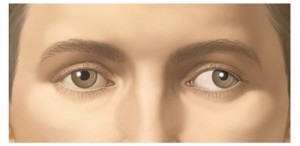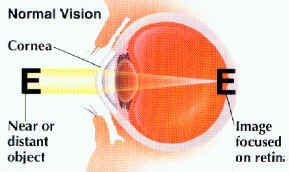Vision Conditions
Amblyopia
 Amblyopia, commonly called "lazy eye", occurs when one eye develops differently than the other eye, causing one eye to be weaker than the other. Sometimes a difference in focusing ability causes one eye to be used more often. Other times, the eyes are misaligned, causing one eye to "shut off" to avoid double vision. Regardless of the cause, the result is a weakened, or amblyopic eye.
Amblyopia, commonly called "lazy eye", occurs when one eye develops differently than the other eye, causing one eye to be weaker than the other. Sometimes a difference in focusing ability causes one eye to be used more often. Other times, the eyes are misaligned, causing one eye to "shut off" to avoid double vision. Regardless of the cause, the result is a weakened, or amblyopic eye.
Symptoms
This condition affects approximately 2 or 3 out of every 100 people. The best time to correct amblyopia is during infancy or early childhood. It's hard to spot amblyopia. Sometimes a child will noticeably favor one eye over the other. Another possible symptom is the child frequently bumping into things on one side. The best way to tell if your child has a lazy eye is through a complete exam around six months and three years. Early diagnosis can prevent amblyopia from leading to more serious problems such as loss of the ability to see three dimensions or functional blindness in the amblyopic eye.
Treatment
Most of the time amblyopia can't be entirely corrected. The amblyopic eye will most likely always be a bit weaker than the other. However, with treatment, vision in the amblyopic eye can be improved to some extent. Treatment involves encouraging the weak eye to develop. This is done using eye patches and glasses. The strong eye may be patched to encourage the weak eye to develop. If a focusing error is the root of the problem, then glasses may reduce the error.
Astigmatism
 Sometimes the cornea is irregularly shaped, causing the eye to focus an object on two different areas of the retina. This is known as astigmatism. For the cornea to bend light correctly, it should be dome shaped, like a basketball. Astigmatic corneas are shaped more like a football. This causes a distorted view when looking at objects, which are close-up and far away. The cause of astigmatism is unknown. Astigmatism is often associated with myopia and hyperopia, and usually occurs from birth. It may be hereditary or it may be caused by factors such as pressure on the cornea.
Sometimes the cornea is irregularly shaped, causing the eye to focus an object on two different areas of the retina. This is known as astigmatism. For the cornea to bend light correctly, it should be dome shaped, like a basketball. Astigmatic corneas are shaped more like a football. This causes a distorted view when looking at objects, which are close-up and far away. The cause of astigmatism is unknown. Astigmatism is often associated with myopia and hyperopia, and usually occurs from birth. It may be hereditary or it may be caused by factors such as pressure on the cornea.
Treatment
Mild astigmatism usually doesn't need to be corrected. Eyeglasses, contact lenses, or refractive surgery can correct moderate to high degrees of astigmatism.
Computer Vision Syndrome
Computer vision syndrome (CVS) affects three out of four computer users. It is a series of symptoms related to extended periods of computer usage. Though it is no cause for panic, measures can be taken to relieve symptoms of CVS.
 Symptoms
SymptomsComputer vision syndrome can appear as a variety of symptoms. Headaches, eyestrain, neck and backaches, sensitivity to light, blurred vision, double vision, excessive watering, and dry or irritated eyes are all possible symptoms. Anyone who uses a computer can develop CVS. Your vision, your computer, and the environment where you work are all factors, which can lead to CVS.
Treatment
Computer vision syndrome is treated with glasses. We offer single vision lenses, lined bifocal or trifocal, or no-line bifocal. A light tint and antiglare coating can help cut down on eyestrain. Dr. Sloan has several different options for computer glasses. Blue Tech and Recharge lenses will protect the membrane from damage 480-520 mm emitted by blue screens reduces eye strain and normalizes circadian rhythm.
Emmetropia
 When an eye's optical power is perfectly matched to its length, the eye is said to be emmetropic. Emmetropia is the medical term for 20/20 vision, needing no corrective lenses or contact lenses for distance vision. It occurs because the optical power of the eye can perfectly focus an image at distance to the retina, giving them "perfect" vision.
When an eye's optical power is perfectly matched to its length, the eye is said to be emmetropic. Emmetropia is the medical term for 20/20 vision, needing no corrective lenses or contact lenses for distance vision. It occurs because the optical power of the eye can perfectly focus an image at distance to the retina, giving them "perfect" vision.
The opposite of emmetropia is ametropia. With ametropia, the focal point of the eye is some distance in from front of or behind the retina and requires glasses or contact lenses to focus on the retina and thus be able to see clearly.
Hyperopia
 Hyperopia is more commonly known as farsightedness. As the name suggests, people with farsightedness are more able to focus on objects that are further away, but with higher levels of farsightedness, even that is difficult. They also can have difficulty focusing on objects, which are very close, and this becomes worse as a person gets older. This is because the eyeball is shorter than normal, which prevents the crystalline lens in the eye from focusing correctly on the retina. About a fourth of the population is afflicted with hyperopia.
Hyperopia is more commonly known as farsightedness. As the name suggests, people with farsightedness are more able to focus on objects that are further away, but with higher levels of farsightedness, even that is difficult. They also can have difficulty focusing on objects, which are very close, and this becomes worse as a person gets older. This is because the eyeball is shorter than normal, which prevents the crystalline lens in the eye from focusing correctly on the retina. About a fourth of the population is afflicted with hyperopia.
A family history of hyperopia is a risk factor for developing hyperopia. Often babies are born with hyperopia, but they can usually out-grow the condition as the eye develops into the correct shape.
Treatment
This condition can be corrected with glasses or contact lenses. There are also surgical procedures that can correct hyperopia.
Myopia
 Myopia is the medical term for what most people call nearsightedness. It is a condition where you can see objects clearly only when they are closer, but when objects are further away you can't focus on them. Myopia usually develops in early childhood, though it sometimes develops in early adulthood. In rare cases, severe myopia can be associated with more serious conditions such as a retinal detachment.
Myopia is the medical term for what most people call nearsightedness. It is a condition where you can see objects clearly only when they are closer, but when objects are further away you can't focus on them. Myopia usually develops in early childhood, though it sometimes develops in early adulthood. In rare cases, severe myopia can be associated with more serious conditions such as a retinal detachment.
Myopia has some genetic tendencies. If your parents are nearsighted, you are at greater risk of also being nearsighted.
Treatment
Myopia can be accommodated and sometimes corrected with glasses or contact lenses. Sometimes myopia continues to gradually worsen throughout life. It can also be corrected by LASIK surgery.
Presbyopia
 As people get older, usually around mid to late 40s, a condition called presbyopia can set in. Presbyopia is the inability to focus on objects near the eye. One usually notices that it is harder to read or use the computer. Presbyopia is a natural consequence of the aging process. Even if someone has never had vision problems before, they can still develop presbyopia.
As people get older, usually around mid to late 40s, a condition called presbyopia can set in. Presbyopia is the inability to focus on objects near the eye. One usually notices that it is harder to read or use the computer. Presbyopia is a natural consequence of the aging process. Even if someone has never had vision problems before, they can still develop presbyopia.
Symptoms
Symptoms may include: having to hold things at arm's length to see them clearly, eye strain, fatigue, and headaches from near work.
Treatment
Presbyopia can be corrected with glasses or contact lenses. You can choose to have glasses with a bifocal or trifocal or reading glasses that you would wear just for near work. Monovision or bifocal contact lenses are available if you do not like wearing glasses.
Keratoconus
Keratoconus is a vision disorder that occurs when the normally round cornea (the front part of the eye) becomes thin and irregular (cone) shaped. This abnormal shape prevents the light entering the eye from being focused correctly on the retina and causes distortion of light.In its earliest stages, keratoconus causes slight blurring and distortion of vision and increased sensitivity to glare and light. These symptoms usually appear in the late teens or late twenties.
Keratoconus may progress for 10-20 years and then slow in its progression. Each eye may be affected differently. As keratoconus progresses, the cornea bulges more and vision may become more distorted. In a small number of cases, the cornea will swell and cause a sudden and significant decrease in vision. The swelling occurs when the strain of the cornea's protruding cone-like shape causes a tiny crack to develop. The swelling may last for weeks or months as the crack heals and is gradually replaced by scar tissue. If this sudden swelling does occur, your doctor can prescribe eye drops for temporary relief, but there are no medicines that can prevent the disorder from progressing.
Eyeglasses or soft contact lenses may be used to correct the mild nearsightedness and astigmatism that is caused by the early stages for keratoconus. As the disorder progresses and cornea continues to thin and change shape, rigid gas permeable contact lenses can be prescribed to correct vision adequately. In most cases, this is adequate. The contact lenses must be carefully fitted, and frequent checkups and lens changes may be needed to achieve and maintain good vision.
In a few cases, a corneal transplant is necessary. However, even after a corneal transplant, eyeglasses or contact lenses are often still needed to correct vision.


